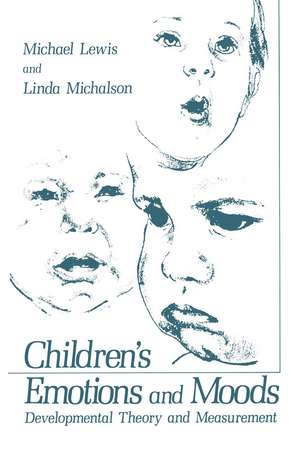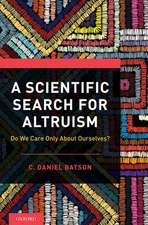Children’s Emotions and Moods: Developmental Theory and Measurement
Editat de Michael Lewisen Limba Engleză Paperback – noi 2011
Preț: 398.15 lei
Nou
Puncte Express: 597
Preț estimativ în valută:
76.20€ • 79.26$ • 62.90£
76.20€ • 79.26$ • 62.90£
Carte tipărită la comandă
Livrare economică 15-29 aprilie
Preluare comenzi: 021 569.72.76
Specificații
ISBN-13: 9781461336228
ISBN-10: 1461336228
Pagini: 492
Ilustrații: XVI, 472 p.
Dimensiuni: 152 x 229 x 26 mm
Greutate: 0.65 kg
Ediția:Softcover reprint of the original 1st ed. 1983
Editura: Springer Us
Colecția Springer
Locul publicării:New York, NY, United States
ISBN-10: 1461336228
Pagini: 492
Ilustrații: XVI, 472 p.
Dimensiuni: 152 x 229 x 26 mm
Greutate: 0.65 kg
Ediția:Softcover reprint of the original 1st ed. 1983
Editura: Springer Us
Colecția Springer
Locul publicării:New York, NY, United States
Public țintă
ResearchCuprins
1. Why Study Emotion?.- Why Not Study Cognition?.- 2. Emotion: An Overview.- What is Emotion?.- Emotion versus Affect.- Primary versus Secondary or Derived Emotions.- Emotion, Mood, and Personality.- Individual Differences in Emotion.- 3. Approaches to the Study of Emotion.- Philosophical Inquiries into Emotion.- The Physiological Approach.- The Cognitive Approach.- The Motivational Approach.- The Cognitive-Emotional Eugue.- 4. The Structure of Emotion: The Development of Five Components.- Emotional EJicitors.- Emotional Receptors.- Emotional States.- Emotional Expressions.- Emotional Experiences.- 5. The Development of Emotion.- A Model of Emotion.- Specific Developmental Issues.- 6. The Socialization of Emotion: How and When to Express Emotions.- Issues in the Socialization of Emotion.- How to Express Emotions: The Use of Display Rules.- When to Express Emotions: Knowledge of Emotions by Situation.- 7. The Socialization of Emotion: How Emotions Are Managed, Labeled, and Interpreted.- How Emotions Are Managed: The Use of Others.- How Emotions Are Labeled: The Acquisition of an Affect Lexicon.- How Emotions Are Interpreted.- 8. The Measurement of Emotion.- Emotions as Private Acts.- The Meaning of Behavior.- Stimulus or Contextual Meaning.- 9. Construction of the Scales of Socioemotional Development.- Which Emotions Should Be Studied?.- Where Should Emotions Be Studied?.- Which Situations Should Be Used?.- Which Behaviors Should Be Used?.- The Scales of Socioemotional Development.- 10. Internal Properties of the Scales.- Method.- Internal Consistency of the Domain Scales.- Independence of the Domain Scales.- 11. Individual Differences in Emotional States.- Age and Gender Differences.- Social Milieu Differences.- Relationships among Emotional States.- Patterns of Emotional States.- 12. Profiles of Enduring Emotional States (Moods).- Constructing Individual Profiles.- Case Studies.- Concluding Remarks.- References.- Appendix A. Scales of Socioemotional Development.- Appendix B. Coding Forms for the Scales of Socioemotional Development.- Author Index.



























